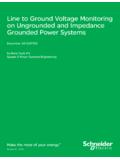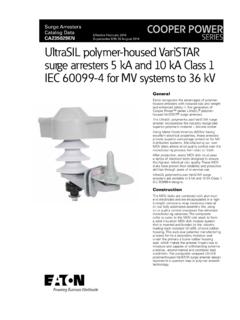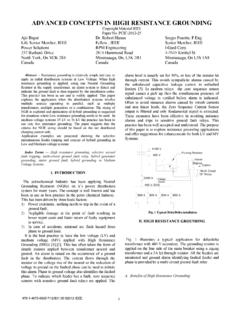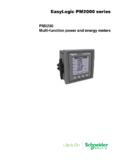Transcription of OPERATING MANUAL FOR THE 30KV A.C. TEST SET
1 1 OPERATING MANUAL FOR THE 30KV TEST SET P123 Product: High voltage AC Test Set Type: P123 Bicotest High voltage Products Ltd Hellesdon Park Road, Drayton High Road, Norwich NR6 5DR United Kingdom Phone +44 1603 416 900 Fax +44 1603 416 902 HIGH voltage EQUIPMENT PLEASE READ CAREFULLY BEFORE OPERATING . SAFETY IS THE RESPOSIBILITY OF THE USER 2 GENERAL SAFETY STATEMENT The following safety precautions should be reviewed to avoid injury to the user and damage to the product (and other products connected to it). To avoid potential hazards only use this product as specified. Only suitably qualified personnel should use this equipment. Servicing of this product should only be carried out by suitably qualified service personnel.
2 The high voltage generated by this unit is extremely dangerous and may be fatal. To Avoid Fire Hazards and Personal Injury Use the correct power supply lead. Only use a suitably rated and approved power supply lead for the country of use. Ensure that systems that the unit is to be connected to are dead. Do not connect and disconnect leads whilst outputs are switched on. Ensure that the product is grounded. To avoid electric shock it is essential that the grounding conductor is connected to the earth ground. Additional earth terminals are provided on the control unit and HV transformer that must be connected to a local earth. Ensure that the unit is properly grounded before making any connections to inputs or outputs.
3 Terminal ratings must be observed to prevent fire hazards and risk of injury to the operator. Consult the product MANUAL for ratings information before making connections to any terminal. It is ESSENTIAL to consult the product MANUAL for rating information before making any connection to a terminal or terminal group marked with a warning triangle. Only use fuses of a type and rating specified for this product. Do not operate the unit out of its case or with any covers or panels removed. Do not touch exposed connections and components when power is present. Do not operate the product if any damage is suspected. Refer the unit to qualified service personnel to be checked. Do not operate the unit in wet or damp conditions Do not operate the unit in an explosive atmosphere If any further queries occur regarding the usage and maintenance of the equipment detailed in this MANUAL , please refer these to the supplier of the equipment in the first case or to: Bicotest High voltage Products Ltd 3 HIGH voltage SAFETY It is essential to follow safe working procedures when working with high voltage .
4 Information on accepted codes of practice should be obtained from your local heath and safety regulatory body. IEEE standard 510-1983 (IEEE Recommended Practices for Safety in High- voltage and High-Power Testing) provides a working framework for establishing safe procedures, but must be read in conjunction with local regulations and accepted codes of practice. The following excerpts are taken from IEEE 510 All ungrounded terminals of the test equipment or apparatus under test should be considered as energised. Common ground connections should be solidly connected to both the test set and the test specimen. As a minimum, the current capacity of the ground leads should exceed that necessary to carry the maximum possible ground current.
5 The effect of ground potential rise due to the resistance and reactance of the earth connection should be considered. Precautions should be taken to prevent accidental contact of live terminals by personnel, either by shielding the live terminals or by providing barriers around the area. The circuit should include instrumentation for indicating the test voltages. Appropriate switching and, where appropriate, an observer should be provided for the immediate de-energisation of test circuits for safety purposes. In the case of dc tests, provisions for discharging and grounding charged terminals and supporting insulation should also be included. High- voltage and high-power tests should be performed and supervised by qualified personnel.
6 Consideration should be given to safety regulations which may apply to specific circumstances; for example, HSE, company, or government regulations. In the use of signal-gathering equipment, each device should be used in such a manner that it will not present a personnel hazard should it inadvertently become a part of the high- voltage circuit, or fail to function properly. 4 SAFETY TERMS AND SYMBOLS The following safety symbols appear on the equipment: CAUTION/WARNING Refer to MANUAL DANGER High voltage Mains off Mains on The following safety symbols appear in this MANUAL : CAUTION This action or procedure may be dangerous if not carried out correctly, and may cause damage to the equipment or connected equipment.
7 WARNING This action or procedure may be cause injury or death to the operator or other personnel if not carried out correctly using applicable safety procedures. 5 CONTENTS 1. DESCRIPTION OF EQUIPMENT 6 Electrical Specification 6 Supply Requirements 6 Output Specifications 6 Zero voltage Interlock: 6 Output voltage Control 6 Overload Protection 7 Variable overload 7 Metering 7 Construction 7 2. OPERATION 8 Safety 8 Installation 8 Operation 8 Connections (See Figure 1) 10 Front Panel Control Functions 11 Method of Operation 13 3. MAINTENANCE 14 4. STANDARD ACCESSORIES 15 5. OVERALL PERFORMANCE SPECIFICATION 16 6. CALIBRATION RESULTS 17 6 1.
8 DESCRIPTION OF EQUIPMENT Electrical Specification Supply Requirements The supply voltage will be as follows: 220/240V 1 phase 50/60Hz+10% 1200VA max 115V 1 phase 50/60Hz +10% -6% 1200VA max Output Specifications The output voltage , current and duty cycle are as follows: Output voltage Output current Continuous 5 min on/15 min off P123 30kV 20mA 40mA One side of the high voltage transformer output is connected to the earth system of the equipment. Zero voltage Interlock: The equipment is fitted with a zero volt interlock system on the controlling regulator. This interlock prevents the output being energised unless the controlling regulator is in the minimum output position.
9 Output voltage Control The output is controlled from zero by means of a regulating transformer. The transformer is operated by means of a control knob which is located on the front panel. To increase the output voltage the knob is turned in a clockwise direction. 7 Overload Protection The equipment is fitted with fixed and variable overload protection circuits as standard. Variable overload The variable overload protection system senses current changes in the high voltage circuit. The trip level is adjusted by means of a selector switch on the front panel of the unit. The switch allows the level to be adjusted from 10-110% of normal full load current in eleven steps. The circuit will activate when the load current exceeds that set by the trip level selector switch.
10 The circuit will respond to more slowly to changing levels of load current. IMPORTANT NOTE: The variable overload trip circuit does not limit the output current on short circuit. Metering The equipment is provided with the following metering: a. A moving coil dual range kilovoltmeter monitoring the output voltage from the equipment. b. A moving coil single range milliammeter monitoring the secondary current of the high voltage transformer. Construction The equipment is housed in a robust case with recessed carrying handles. All the controls and metering are located on the front panel together with all external connections. 8 2. OPERATION Safety The output from the P123 is extremely dangerous, and if used incorrectly could be fatal.




